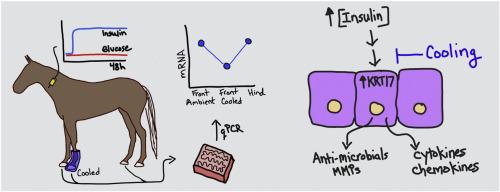Veterinary Immunology and Immunopathology ( IF 1.4 ) Pub Date : 2021-09-21 , DOI: 10.1016/j.vetimm.2021.110326 Lynne Cassimeris 1 , Caitlin Armstrong 2 , Quinnlyn C Burger 1 , Simon Stokes 3 , Andrew van Eps 2 , Hannah Galantino-Homer 2

|
The euglycemic hyperinsulinemic clamp model (EHC) of equine endocrinopathic laminitis induces rapid loss of lamellar tissue integrity, disrupts keratinocyte functions, and induces inflammation similar to natural disease. Continuous digital hypothermia (CDH) blocks tissue damage in this experimental model, allowing identification of specific genes or molecular pathways contributing to disease initiation or early progression. Archived lamellar tissues (8 horses, 48 h EHC treatment, including CDH-treated front limbs) were used to measure relative expression levels of genes encoding keratin 17 (KRT17), a stress-induced intermediate filament protein, and genes upregulated downstream of keratin 17 and/or interleukin 17A (IL-17A), as mediators of inflammation. Compared to front or hind limbs at ambient temperature, CDH resulted in significantly lower expression of KRT17, CCL2, CxCL8, PTGS2 (encoding COX2), IL6, TNFα, S100A8 and MMP1. By immunofluorescence, COX2 was robustly expressed in lamellar keratinocytes from ambient limbs, but not in CDH-treated limbs. Genes not significantly reduced by CDH were IL17A, DEFB4B, S100A9 and MMP9. Overall, 8 of 12 genes were expressed at lower levels in the CDH-treated limb. These 8 genes are expressed by wounded or stress-activated keratinocytes in human disease or mouse models, highlighting the role of keratinocytes in equine laminitis.
中文翻译:

持续的手指低温降低高胰岛素血症引起的马蹄叶炎中角蛋白 17 和 1L-17A 炎症通路介质的表达
马内分泌病性椎板炎的正常血糖高胰岛素钳夹模型 (EHC) 会导致板层组织完整性迅速丧失,破坏角质形成细胞功能,并诱发类似于自然疾病的炎症。在这个实验模型中,连续数字低温 (CDH) 可以阻止组织损伤,从而可以识别导致疾病发生或早期进展的特定基因或分子途径。存档的层状组织(8匹马,48小时EHC处理,包括CDH处理的前肢)用于测量编码角蛋白17(KRT17)的基因的相对表达水平,这是一种应激诱导的中间丝蛋白,以及在角蛋白17下游上调的基因和/或白细胞介素 17A ( IL-17A),作为炎症的介质。与环境温度下的前肢或后肢相比,CDH 导致KRT17、CCL2、CxCL8、PTGS2(编码 COX2)、IL6、TNFα、S100A8和MMP1的表达显着降低。通过免疫荧光,COX2 在来自周围肢体的层状角质形成细胞中强烈表达,但在 CDH 治疗的肢体中没有。CDH 未显着降低的基因是IL17A、DEFB4B、S100A9和MMP9. 总体而言,12 个基因中有 8 个在 CDH 治疗的肢体中以较低水平表达。这 8 个基因在人类疾病或小鼠模型中由受伤或应激激活的角质形成细胞表达,突出了角质形成细胞在马蹄叶炎中的作用。











































 京公网安备 11010802027423号
京公网安备 11010802027423号